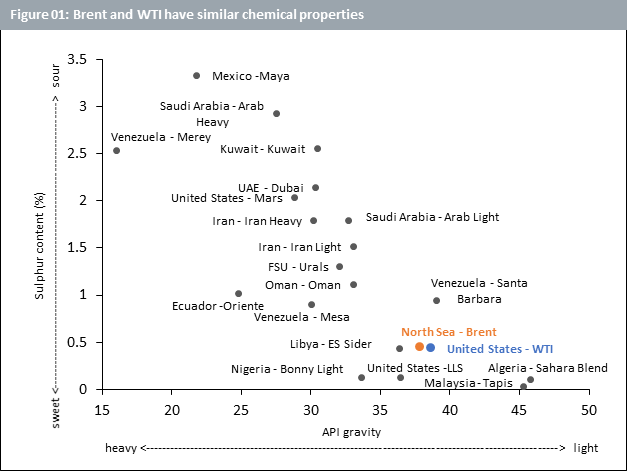Analys
Brent and WTI – A tale of two benchmarks


Brent and West Texas Intermediate (WTI) are two globally recognised oil benchmarks. When market participants refer to the price of oil, they typically refer to one or the other or both. But despite having quite similar chemical properties, there are important distinguishing features between the two. Financial markets recognise these differences and, as a result, price the two differently. The two benchmarks have contrasting features in terms of where the oil is produced, how it is stored and transported and the way it is traded in international markets. These differences not only explain the historical price discrepancy between the two, but also help us understand why the two have behaved differently during the coronavirus pandemic and the ensuing market volatility. This article will contrast the distinguishing features between the two and, after developing a new lens to view the two benchmarks, replay the recent episode when WTI prices crashed into negative territory. The article will conclude by outlining the forces which will shape the fluid commodity going forward.
Same, same, but different
In ‘A tale of Two Cities’ by Charles Dickens, Sydney Carton sacrifices his life to save Charles Darnay, who is married to the woman Carton loves, by taking his place in prison moments before he is taken to the guillotine during the French revolution. He is able to pull off this selfless act of bravery thanks to the uncanny resemblance between him and Darnay. Similarly, most people would not be able to tell the difference if a barrel of WTI was replaced with one for Brent given the likeness between the two. Both Brent and WTI are referred to as light and sweet. They are ‘light’ in terms of the American Petroleum Institute (API) gravity. Having an API gravity greater than 10 makes them light and allows them to float on water, while an API gravity of less than 10 would have caused them to sink. Similarly, both have low sulphur content making them ‘sweet’ and easy to refine (See Figure 01).

But while Carton and Darnay looked alike, they were distinctly different individuals. Brent and WTI too, despite their resemblance, have their disparities. Brent Crude is extracted from the North Sea. Oil production from Europe, Africa and the Middle East tends to use Brent as its main benchmark. This accounts for around two-thirds of internationally traded crude oil. The Organisation of the Petroleum Exporting countries (OPEC), an intergovernmental organisation comprising 13 key oil producing countries as well as their 10 partner countries (collectively referred to as OPEC+), also typically use Brent as their oil price benchmark. In contrast, WTI is sourced primarily from Texas and most oil production in the US uses WTI as its main benchmark.

Brent and WTI have always traded at different prices giving rise to the Brent – WTI spread (Figure 02). Purely in terms of quality, WTI has a slight edge over Brent on account of its lower sulphur content making it moderately ‘sweeter’ and thus easier to refine. For this reason, WTI ought to theoretically trade at a premium over Brent. For a large part of the first decade of this century, WTI did indeed trade at a premium, i.e. the Brent – WTI spread was negative. Over the last decade however, the shale revolution in the US has brought large volumes of oil into the market making the US one of the largest oil producers in the world. The shale revolution refers to a combination of technological improvements and financial infrastructure enabling the US to produce oil from low-permeable shale, sandstone and carbonate rock formations in larger quantities than ever before. The shale oil industry has grown rapidly since 2011 and accounted for 63% of total US crude oil production in 2019 (according to the US Energy Information Administration). In line with economic principles of demand and supply, as the total volume of oil production increased in the US, this put downward pressure on WTI. The Brent – WTI spread has generally been positive in the last decade.
Another reason for the Brent – WTI spread is the logistical challenge for the US to transport oil from landlocked production hubs through a network of pipelines and to ship it overseas. This impinges on the overseas demand for oil from the US (WTI). In contrast, Brent is produced at or closer to sea making it easier for it to reach its overseas destinations. The US is however investing heavily in its pipeline infrastructure to enable it to send large vessels of oil from its shores to international buyers. Several such infrastructure projects are expected to be completed by 2021-2022 when we might see an increase in demand for WTI and thus a narrowing of its spread with Brent.
The historic WTI crash
The explanation above of the spread between the two benchmarks omits any discussion about the unprecedented spike on 20 April 2020. This section will unravel the story behind the anomalous occurrence.
On Monday 20 April 2020, markets witnessed a historic crash in WTI prices (Figure 03). The crash occurred a day before the active Nymex WTI futures contract was due to expire. This contract, meant to deliver oil between 01 May and 31 May, crashed into negative territory as oil storage in the US became very tight. With the coronavirus pandemic causing considerable oil demand destruction putting entire countries in lockdown and bringing economic activity to a grinding halt, the reduction in oil production was not enough to balance the market creating a supply glut. The main delivery and settlement point in Cushing, Oklahoma was approaching its storage limit with any additional capacity likely already leased out or earmarked for other purposes. This acute pressure, so close to contract expiry at the point where contracts settle, contributed to the negative price. Those taking physical delivery from the expiring futures contract were being paid to take the oil and find a place to store it. The May contract expired the following day in slightly positive territory. When the June contract became the active contract upon the May contract’s expiry, prices recovered further as the issue of June deliveries creating the same problem was less worrying, at least at that point.

But Brent did not endure a similar crash. The main reason for this is that WTI, traded on the New York Mercantile Exchange (NYMEX), is a deliverable futures contract. Thus, upon expiry, the holder of the futures contract takes delivery of the underlying, i.e. barrels of oil. Brent however, traded on the Intercontinental Exchange (ICE), has a cash settlement procedure whereby the holder of the futures contract need not take delivery of the underlying upon expiry. Therefore, storage issues create a more direct risk to investors in WTI futures.
Outside of this idiosyncrasy pertaining to futures trading, the two benchmarks generally move with a high degree of correlation (Figure 04). At the peak of the coronavirus pandemic’s acceleration in April, a third of global oil demand was wiped out. Soon thereafter, major oil producers Saudi Arabia and Russia engaged in a price war. This created a double shock for oil as the suppliers opened the floodgates at a time when demand had just crashed. Both benchmarks experienced severe price weakness. But as policy decisions from OPEC+ can be expected to impact Brent prices more than WTI, the deal reached by the group at the start of April to cut suppliesprovided slightly more cushioning to Brent.

What happens next?
With a deeper understanding of the drivers of the two benchmarks, historic and recent price behaviour makes more sense. But the all-important question is, “what happens next?”. The fate of oil prices rests heavily on how quickly the world can overcome the pandemic and get the economic engines firing again. Volatility in oil prices may persist in the coming weeks, or even months, until uncertainty with regards to the pandemic and lockdowns diminishes. The relative price behaviour of WTI and Brent during this period will depend on the degree to which producers in the US and OPEC+ cut supplies to balance the market.
We however hope to paint a more optimistic picture of the world in the second half of this year. Oil prices may not recover quickly to where they were in February this year due to an overhang of excess supply, a fractured OPEC+ and a dented global economic engine. Nonetheless, after all the pain, the world will eventually return to some semblance of normalcy. Manufacturers will switch their machines on again, cars will return to the roads and aeroplanes will return to the skies. Once again, oil is expected to be in demand. And while one protagonist had to sacrifice himself to save the other in the tale told by Dickens, we expect both mainstays from the tale of two benchmarks to rise again when the crisis is over.
Mobeen Tahir, Associate Director, Research, WisdomTree
DISCLAIMER
This material is prepared by WisdomTree and its affiliates and is not intended to be relied upon as a forecast, research or investment advice, and is not a recommendation, offer or solicitation to buy or sell any securities or to adopt any investment strategy. The opinions expressed are as of the date of production and may change as subsequent conditions vary. The information and opinions contained in this material are derived from proprietary and non-proprietary sources. As such, no warranty of accuracy or reliability is given and no responsibility arising in any other way for errors and omissions (including responsibility to any person by reason of negligence) is accepted by WisdomTree, nor any affiliate, nor any of their officers, employees or agents. Reliance upon information in this material is at the sole discretion of the reader. Past performance is not a reliable indicator of future performance.
Analys
Tightening fundamentals – bullish inventories from DOE

The latest weekly report from the US DOE showed a substantial drawdown across key petroleum categories, adding more upside potential to the fundamental picture.

Commercial crude inventories (excl. SPR) fell by 5.8 million barrels, bringing total inventories down to 415.1 million barrels. Now sitting 11% below the five-year seasonal norm and placed in the lowest 2015-2022 range (see picture below).
Product inventories also tightened further last week. Gasoline inventories declined by 2.1 million barrels, with reductions seen in both finished gasoline and blending components. Current gasoline levels are about 3% below the five-year average for this time of year.
Among products, the most notable move came in diesel, where inventories dropped by almost 4.1 million barrels, deepening the deficit to around 20% below seasonal norms – continuing to underscore the persistent supply tightness in diesel markets.
The only area of inventory growth was in propane/propylene, which posted a significant 5.1-million-barrel build and now stands 9% above the five-year average.
Total commercial petroleum inventories (crude plus refined products) declined by 4.2 million barrels on the week, reinforcing the overall tightening of US crude and products.


Analys
Bombs to ”ceasefire” in hours – Brent below $70

A classic case of “buy the rumor, sell the news” played out in oil markets, as Brent crude has dropped sharply – down nearly USD 10 per barrel since yesterday evening – following Iran’s retaliatory strike on a U.S. air base in Qatar. The immediate reaction was: “That was it?” The strike followed a carefully calibrated, non-escalatory playbook, avoiding direct threats to energy infrastructure or disruption of shipping through the Strait of Hormuz – thus calming worst-case fears.

After Monday morning’s sharp spike to USD 81.4 per barrel, triggered by the U.S. bombing of Iranian nuclear facilities, oil prices drifted sideways in anticipation of a potential Iranian response. That response came with advance warning and caused limited physical damage. Early this morning, both the U.S. President and Iranian state media announced a ceasefire, effectively placing a lid on the immediate conflict risk – at least for now.
As a result, Brent crude has now fallen by a total of USD 12 from Monday’s peak, currently trading around USD 69 per barrel.
Looking beyond geopolitics, the market will now shift its focus to the upcoming OPEC+ meeting in early July. Saudi Arabia’s decision to increase output earlier this year – despite falling prices – has drawn renewed attention considering recent developments. Some suggest this was a response to U.S. pressure to offset potential Iranian supply losses.
However, consensus is that the move was driven more by internal OPEC+ dynamics. After years of curbing production to support prices, Riyadh had grown frustrated with quota-busting by several members (notably Kazakhstan). With Saudi Arabia cutting up to 2 million barrels per day – roughly 2% of global supply – returns were diminishing, and the risk of losing market share was rising. The production increase is widely seen as an effort to reassert leadership and restore discipline within the group.
That said, the FT recently stated that, the Saudis remain wary of past missteps. In 2018, Riyadh ramped up output at Trump’s request ahead of Iran sanctions, only to see prices collapse when the U.S. granted broad waivers – triggering oversupply. Officials have reportedly made it clear they don’t intend to repeat that mistake.
The recent visit by President Trump to Saudi Arabia, which included agreements on AI, defense, and nuclear cooperation, suggests a broader strategic alignment. This has fueled speculation about a quiet “pump-for-politics” deal behind recent production moves.
Looking ahead, oil prices have now retraced the entire rally sparked by the June 13 Israel–Iran escalation. This retreat provides more political and policy space for both the U.S. and Saudi Arabia. Specifically, it makes it easier for Riyadh to scale back its three recent production hikes of 411,000 barrels each, potentially returning to more moderate increases of 137,000 barrels for August and September.
In short: with no major loss of Iranian supply to the market, OPEC+ – led by Saudi Arabia – no longer needs to compensate for a disruption that hasn’t materialized, especially not to please the U.S. at the cost of its own market strategy. As the Saudis themselves have signaled, they are unlikely to repeat previous mistakes.
Conclusion: With Brent now in the high USD 60s, buying oil looks fundamentally justified. The geopolitical premium has deflated, but tensions between Israel and Iran remain unresolved – and the risk of missteps and renewed escalation still lingers. In fact, even this morning, reports have emerged of renewed missile fire despite the declared “truce.” The path forward may be calmer – but it is far from stable.
Analys
A muted price reaction. Market looks relaxed, but it is still on edge waiting for what Iran will do

Brent crossed the 80-line this morning but quickly fell back assigning limited probability for Iran choosing to close the Strait of Hormuz. Brent traded in a range of USD 70.56 – 79.04/b last week as the market fluctuated between ”Iran wants a deal” and ”US is about to attack Iran”. At the end of the week though, Donald Trump managed to convince markets (and probably also Iran) that he would make a decision within two weeks. I.e. no imminent attack. Previously when when he has talked about ”making a decision within two weeks” he has often ended up doing nothing in the end. The oil market relaxed as a result and the week ended at USD 77.01/b which is just USD 6/b above the year to date average of USD 71/b.

Brent jumped to USD 81.4/b this morning, the highest since mid-January, but then quickly fell back to a current price of USD 78.2/b which is only up 1.5% versus the close on Friday. As such the market is pricing a fairly low probability that Iran will actually close the Strait of Hormuz. Probably because it will hurt Iranian oil exports as well as the global oil market.
It was however all smoke and mirrors. Deception. The US attacked Iran on Saturday. The attack involved 125 warplanes, submarines and surface warships and 14 bunker buster bombs were dropped on Iranian nuclear sites including Fordow, Natanz and Isfahan. In response the Iranian Parliament voted in support of closing the Strait of Hormuz where some 17 mb of crude and products is transported to the global market every day plus significant volumes of LNG. This is however merely an advise to the Supreme leader Ayatollah Ali Khamenei and the Supreme National Security Council which sits with the final and actual decision.
No supply of oil is lost yet. It is about the risk of Iran closing the Strait of Hormuz or not. So far not a single drop of oil supply has been lost to the global market. The price at the moment is all about the assessed risk of loss of supply. Will Iran choose to choke of the Strait of Hormuz or not? That is the big question. It would be painful for US consumers, for Donald Trump’s voter base, for the global economy but also for Iran and its population which relies on oil exports and income from selling oil out of that Strait as well. As such it is not a no-brainer choice for Iran to close the Strait for oil exports. And looking at the il price this morning it is clear that the oil market doesn’t assign a very high probability of it happening. It is however probably well within the capability of Iran to close the Strait off with rockets, mines, air-drones and possibly sea-drones. Just look at how Ukraine has been able to control and damage the Russian Black Sea fleet.
What to do about the highly enriched uranium which has gone missing? While the US and Israel can celebrate their destruction of Iranian nuclear facilities they are also scratching their heads over what to do with the lost Iranian nuclear material. Iran had 408 kg of highly enriched uranium (IAEA). Almost weapons grade. Enough for some 10 nuclear warheads. It seems to have been transported out of Fordow before the attack this weekend.
The market is still on edge. USD 80-something/b seems sensible while we wait. The oil market reaction to this weekend’s events is very muted so far. The market is still on edge awaiting what Iran will do. Because Iran will do something. But what and when? An oil price of 80-something seems like a sensible level until something do happen.
-

 Nyheter3 veckor sedan
Nyheter3 veckor sedanStor uppsida i Lappland Guldprospekterings aktie enligt analys
-

 Nyheter4 veckor sedan
Nyheter4 veckor sedanBrookfield ska bygga ett AI-datacenter på hela 750 MW i Strängnäs
-

 Nyheter3 veckor sedan
Nyheter3 veckor sedanSilverpriset släpar efter guldets utveckling, har mer uppsida
-

 Nyheter4 veckor sedan
Nyheter4 veckor sedanTradingfirman XTX Markets bygger datacenter i finska Kajana för 1 miljard euro
-

 Nyheter2 veckor sedan
Nyheter2 veckor sedanUppgången i oljepriset planade ut under helgen
-

 Nyheter2 veckor sedan
Nyheter2 veckor sedanLåga elpriser i sommar – men mellersta Sverige får en ökning
-

 Analys2 veckor sedan
Analys2 veckor sedanVery relaxed at USD 75/b. Risk barometer will likely fluctuate to higher levels with Brent into the 80ies or higher coming 2-3 weeks
-

 Nyheter1 vecka sedan
Nyheter1 vecka sedanMahvie Minerals växlar spår – satsar fullt ut på guld









